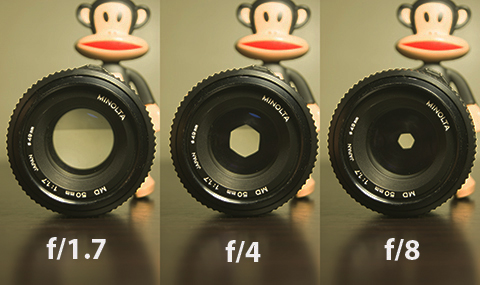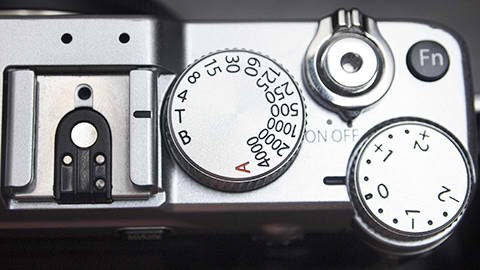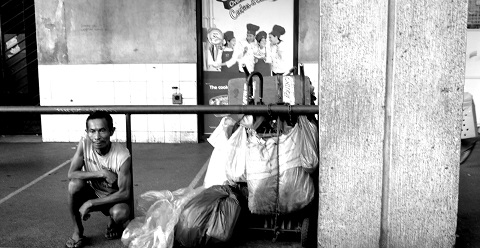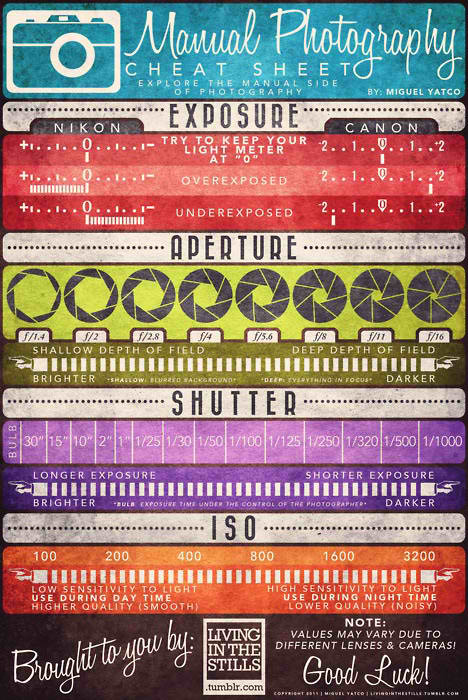One of the key elements of photography is working with light and getting just the right amount of it so your pictures end up visually appealing. In this segment, we’ll give you an introduction on exposure and how each of its facets affects your composition.
By definition, Exposure is the amount of light (natural or artificial) that a camera’s sensor (or film) is exposed to. Therefore, depending on how much light was allowed to hit the sensor, an image can be underexposed (dark) or overexposed (bright).

Exposure can be altered to meet the envisioned outcome of the user. This is done by adjusting key photography elements whether in-camera (ISO and Shutter speed) or off-camera (Aperture). We’ll discuss each of these aspects as we go along, starting with Aperture.
Aperture
In layman’s term, Aperture is described as the opening of the lens mechanically controlled by several blades which restricts the amount of light that hits the sensor. It works similarly to our eye’s pupil; it dilates or contracts to compensate for the intensity of the light.

Aperture is measured in f-stop which is somewhat confusing particularly to those who are starting out in photography. A lower number (ex. f/1.8) denotes a larger lens opening which subjects the lens (and the sensor in the process) to more light. On the other hand, a higher number like f/8 translates to a smaller opening.
Depth of field is also a topic of discussion when dealing with aperture. Wikipedia defines it as “the distance between the nearest and farthest objects in a scene that appears acceptably sharp in an image.” In context, DOF deals with the amount of emphasis that a given focus point has in the image as opposed to the foreground/background.

DOF is categorized in to two; shallow and deep. The former is achieved by either shooting at a wider aperture or by moving the subject as far away as possible from the background. As a result, you’re drawing more emphasis to the main subject by blurring background/foreground.
Conversely, if you want the other portions of the image to be as defined as the subject as possible, you can either move the main subject (Teddy) closer to the background (Paul Frank) or shoot at a smaller aperture like what we did on the right-most picture.
Shutter Speed
If Aperture controls how much light comes in, then Shutter Speed dictates the amount of time that the film or sensor is exposed to the light. Shutter speed is measure in seconds which correlates to the time it takes for the whole cycle (opening and closing of the shutter) to complete.

In practice, the sensor/film records all the light, as well as movements, from the time that the shutter opens until it closes. This means that by shooting at faster shutter speed (half a second or faster) you’re actually letting in less light as opposed to having the shutter open for a second or longer.

Oftentimes, shutter speed is set to less than a second in order to freeze a moment and/or avoid motion blur caused by either unsteady hands during handheld shooting or moving subjects. This “motion blur” is evident on the image above that I took while I was on a moving bus.
There are, however, some instances where a slower shutter speed is required to produce the desired result (as seen in the image below) or what is commonly called as long exposure. With the help of a tripod and an ND Filter, I was able to capture a flowing stream and made the water look creamy or cloud-like.

ISO
Lastly we have ISO, or previously known as DIN and/or ASA back in the days of film cameras. In a nutshell, ISO deals with the sensitivity of sensor or film to light.
Before the advent of digital cameras, the ISO cannot be adjusted in the camera; rather it’s pre-set on the film that you’re using. Fortunately, we won’t have to deal with that anymore as digital cameras are now equipped with various ISO presets that are readily available at your disposal.

Compared to the two previous settings, ISO is a little less complicated to understand. Jargons aside, a lower ISO value (typically 100) means that the image sensor is less susceptible to light. As the ISO value increases, the more that the image sensor is sensitive to light, thus producing a brighter picture.
However, the drawback of shooting at a higher ISO value is that the resulting image may suffer from noise due to the size of the sensor and/or its inability to handle noise at high ISO settings. This is exactly the reason why most photographers shoot at base ISO or the lowest possible value for their camera to yield the crispest possible result.
Conclusion
Whether you wield a dSLR camera or not, having a clear understanding of exposure (and each of its facets) can help improve not only your photography skills, but also the quality of your pictures. And now that you have a better grasp on how each setting affects your composition, all that’s left for you to do is to try it out with your camera and experiment by going Manual.
We’ll end this basic tutorial with some tips and tricks to improve your shot through proper exposure.
• There’s no correct exposure. You can have a slightly over or underexposed picture as longs as it’s visually appealing to you.
• Use your camera’s light meter if it has one, it’ll help you get the proper exposure.
• Shoot at the lowest possible ISO. If it’s inevitable for you to increase the ISO, try not to go beyond 1600.
• Depending on the lens that you’re shooting with, it’s best if you shoot at an aperture that’s one or two stops down. Example, if you’re lens is a 50mm f/1.8, setting the aperture at f/2.8 or even f/4 will yield better result.
• For handheld shooting, try not to go below 1/20 shutter speed as to not cause motion blur.
• Invest on a good tripod, it’ll give you more leeway on using slower shutter speed and allow you to take long exposure shots.
Finally, here’s a cool cheat sheet courtesy of the folks over at Living in the Stills that pretty much sums up what we’ve discussed.

Louie Diangson contributed to this post.

YugaTech.com is the largest and longest-running technology site in the Philippines. Originally established in October 2002, the site was transformed into a full-fledged technology platform in 2005.
How to transfer, withdraw money from PayPal to GCash
Prices of Starlink satellite in the Philippines
Install Google GBox to Huawei smartphones
Pag-IBIG MP2 online application
How to check PhilHealth contributions online
How to find your SIM card serial number
Globe, PLDT, Converge, Sky: Unli fiber internet plans compared
10 biggest games in the Google Play Store
LTO periodic medical exam for 10-year licenses
Netflix codes to unlock hidden TV shows, movies
Apple, Asus, Cherry Mobile, Huawei, LG, Nokia, Oppo, Samsung, Sony, Vivo, Xiaomi, Lenovo, Infinix Mobile, Pocophone, Honor, iPhone, OnePlus, Tecno, Realme, HTC, Gionee, Kata, IQ00, Redmi, Razer, CloudFone, Motorola, Panasonic, TCL, Wiko
Best Android smartphones between PHP 20,000 - 25,000
Smartphones under PHP 10,000 in the Philippines
Smartphones under PHP 12K Philippines
Best smartphones for kids under PHP 7,000
Smartphones under PHP 15,000 in the Philippines
Best Android smartphones between PHP 15,000 - 20,000
Smartphones under PHP 20,000 in the Philippines
Most affordable 5G phones in the Philippines under PHP 20K
5G smartphones in the Philippines under PHP 16K
Smartphone pricelist Philippines 2024
Smartphone pricelist Philippines 2023
Smartphone pricelist Philippines 2022
Smartphone pricelist Philippines 2021
Smartphone pricelist Philippines 2020
Abed says:
Very informative. Thanks sir, will try to explore the manual mode sometime. Haha :)
Thank you thank you! says:
Thank you sir Louie! I appreciate it very much. More please ;-)
thank you thank you! says:
oops sir ronnie pala!
r41 says:
Once again, thank you sir for the very informative article! Good job!
don says:
so informative. gwapo pa ang writer :D
Calvin says:
Sir ronnie, baket yung nagpakuha ako ng pic sayo blurred yung mga shots? :P
Ronnie Bulaong says:
Hehehe… Improve-improve din pag may time. :D
Viiperi says:
Thanks for this! The basic exposure settings found in a DSLR are already found in 808 PureView which allow you to create fantastic light trails with long exposure with the built-in ND Filter, or bokeh lights becauseof the very wide aperture. Check out my Flickr po http://www.flickr.com/PureView
Ronnie Bulaong says:
Wow great shots! Keep it up dude. :D
Jesus says:
Ang galing nito sir Ronnie.
leeto says:
More articles like this please. Could you make articles like this downloadable. thanks.